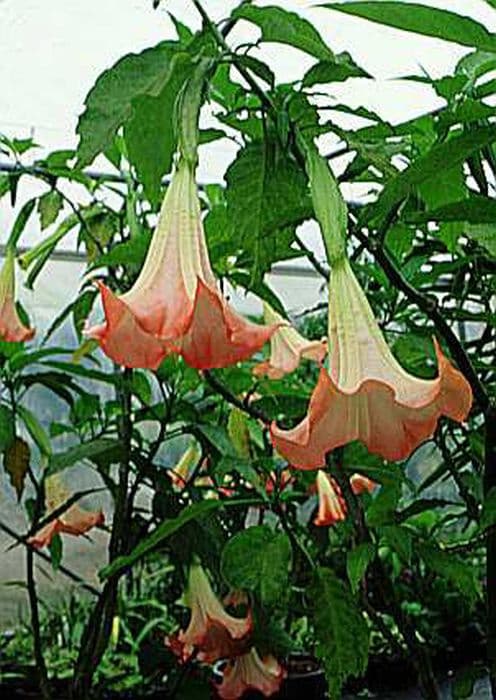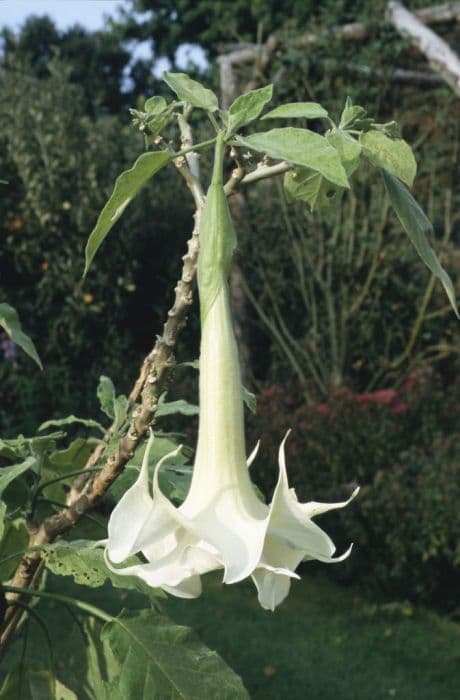Double Petunia Petunia Surfinia Double Blue Star = 'Sunsurfelevi' (PBR) (Surfinia Series) (d)
![petunia [Surfinia Double Blue Star]](/_next/image?url=https%3A%2F%2Fplants-admin.emdemapps.com%2Fimages%2Fplants%2F%2Fimages%2F604b5d462924d.png&w=3840&q=75)
ABOUT
The Petunia Surfinia Double Blue Star, also commonly referred to simply as Surfinia, is a captivating plant known for its lush and vibrant appearance. This variety boasts a mesmerizing color combination with double blooms featuring rich blue petals that are adorned with a distinctive white star at the center, creating a striking contrast. The flowers resemble frilly pom-poms due to their double-layered petal arrangement, which adds a sense of depth and texture to the overall display. The foliage of the Surfinia is equally impressive, with green leaves that provide a lush backdrop for the showy flowers. The leaves are of a moderate size and have a smooth, sometimes slightly sticky texture, which is typical of many petunia varieties. This provides a complementary canvas for the flowers, enhancing their visual impact. With its cascading habit, the Surfinia spills over containers and baskets in a delightful manner, making it a popular choice for adding a splash of color to elevated garden displays or draping gracefully over the edges of pots. Its abundance of blooms creates a full and opulent effect that can add a touch of elegance to any garden setting. This particular variety of Surfinia is loved for its rich coloration and stunning floral patterns, capable of captivating the gaze of onlookers and bringing a serene yet vibrant character to its surroundings.
About this plant
 Names
NamesFamily
Solanaceae.
Synonyms
Double Blue Star Surfinia, Surfinia Double Blue Star Petunia, Surfinia Series Petunia.
Common names
Petunia Surfinia Double Blue Star, Sunsurfelevi
 Characteristics
CharacteristicsLife cycle
Annuals
Foliage type
Evergreen
Color of leaves
Green
Flower color
Blue
Height
6 inches (15 cm)
Spread
2 feet (60 cm)
Plant type
Herb
Hardiness zones
Varies
Native area
South America
Benefits
 General Benefits
General Benefits- Vibrant Flowers: Produces abundant, double-layered vibrant blue flowers with a white star pattern, adding a splash of color to garden spaces.
- Continuous Blooming: Offers a long flowering season from early spring to late fall, providing extended visual interest.
- Trailing Habit: Features a cascading growth habit, making it ideal for hanging baskets, balconies, and containers.
- Low Maintenance: Requires minimal care beyond regular watering and occasional feeding, suitable for busy gardeners.
- Drought Tolerance: Once established, it has a level of drought tolerance, making it suitable for gardeners in drier climates.
- Attracts Pollinators: Invites bees, butterflies, and other beneficial insects into the garden, promoting biodiversity.
- Adaptable Growth: Adapts well to a variety of soil types and sun exposures, from full sun to partial shade.
- Space Efficient: Its compact and neat growth habit makes it an efficient use of space in small garden areas.
- Easy Propagation: Can be easily propagated from cuttings, allowing gardeners to create more plants for other areas or to share with friends.
- Resistant to Pests: Displays a natural resistance to many common garden pests, reducing the need for chemical treatments.
 Medical Properties
Medical PropertiesThis plant is not used for medical purposes.
 Air-purifying Qualities
Air-purifying QualitiesThis plant is not specifically known for air purifying qualities.
 Other Uses
Other Uses- Decorative floaters in water features: These flowers can be used to float on the surface of water gardens or fountains to add a hint of color and natural beauty.
- Insectary plantings: Petunia can serve as a companion plant in vegetable gardens to attract beneficial insects that help with pest control.
- Educational tool in botany: These vibrant blooms can be used to teach about plant genetics and hybridization as they are a result of selective breeding.
- Photography subjects: Due to their unique pattern and color, Petunia Surfinia Double Blue Star flowers make excellent subjects for photographers, especially those specializing in nature and macro photography.
- Live event decor: Whole plants or individual blooms can be used to decorate venues for events like weddings, parties, or corporate events, contributing to a lively ambiance.
- Color dye source: The vibrant blue petals can provide color extract for use in natural dyes for fabrics or art projects.
- Gardening skill development: Caring for these plants can serve as an educational experience for beginner gardeners, teaching them about plant care and floral arrangements.
- Crafts and preservation: The flowers and foliage can be dried and used in creating preserved floral arrangements, wreaths, or other decorative crafts.
- Baking decoration: Edible Petunia flowers can be used to adorn cakes and desserts for an elegant and unique presentation.
- Theme gardens: Petunia Surfinia Double Blue Star can be used to create a "starry night" theme garden due to its celestial pattern and coloring.
Interesting Facts
 Feng Shui
Feng ShuiThe Petunia is not used in Feng Shui practice.
 Zodiac Sign Compitability
Zodiac Sign CompitabilityThe Petunia is not used in astrology practice.
 Plant Symbolism
Plant Symbolism- Anger and Resentment: In some cultures, petunias can be a symbol reflecting anger or resentment, possibly due to the way they can overtake an area if not maintained.
- Desire and Passion: The bold colors of petunias, including the rich blue hues in the Surfinia variety, can represent a strong desire or passionate feelings.
- Soothing Presence: The gentle appearance of the petunia can offer a sense of comfort and peace, thereby symbolizing a soothing presence in chaotic times.
- Hope and Optimism: Flowers in general, including petunias, can embody hope, with their recurrent blooming cycles and vibrant colors uplifting spirits and encouraging a positive outlook.
 Water
WaterFor Petunia Surfinia plants, consistent watering is key, usually when the top inch of soil feels dry. They prefer to be watered deeply but infrequently, which often translates to about 1-2 gallons per week depending on climate conditions and the size of the plant. It's crucial to avoid waterlogging by ensuring good drainage. During hot, dry spells, you might need to water more frequently. Overhead watering should be avoided to prevent disease; instead, water at the base of the plant early in the morning.
 Light
LightPetunia Surfinia thrives in full sun to maintain vibrant flowers and healthy growth. It's best to place them in a spot where they receive at least 6 hours of direct sunlight daily. Areas with morning sun and afternoon shade are typically ideal to protect them from the harshest midday sun while ensuring sufficient light exposure.
 Temperature
TemperaturePetunia Surfinia grows best in temperatures between 60°F and 75°F. They can withstand a maximum temperature of up to 90°F and a minimum of about 40°F, but frost can be detrimental. To ensure optimal growth and flowering, aim to provide them with their ideal temperature range as much as possible.
 Pruning
PruningPruning Petunia Surfinia helps to encourage bushiness and prevents legginess. Lightly pinch back stems every few weeks, especially when the plant starts to look stretched. The best time for pruning is in the mid-summer when you might notice the plant beginning to wane. Regular deadheading of spent flowers also promotes continuous blooming.
 Cleaning
CleaningAs needed
 Soil
SoilSurfinia petunias thrive in a well-draining, fertile potting mix with a pH between 5.5 and 6.0. Mix equal parts of peat moss, perlite, and loamy garden soil to create the ideal environment for these flowers' root systems, and ensure essential nutrients for blooming are present.
 Repotting
RepottingSurfinia petunias typically don't require frequent repotting and can be repotted annually. They are often treated as annuals; however, if overwintered successfully, they should be repotted in the spring before the new growth starts.
 Humidity & Misting
Humidity & MistingSurfinia petunias prefer moderate humidity levels but are adaptable to a wide range of conditions outside of very high humidity, which can promote fungal diseases. Adequate air circulation around the plants can help maintain the ideal humidity level.
 Suitable locations
Suitable locationsIndoor
Place Surfinia petunias in a well-lit spot and ensure regular watering.
Outdoor
Plant Surfinia petunias in full sun with good air circulation.
Hardiness zone
9-11 USDA
 Life cycle
Life cycleThe life of Petunia 'Surfinia Double Blue Star' begins with seed germination, typically in warm, moist soil conditions, where the seed will sprout and develop its first roots and leaves. This is followed by the vegetative stage, where the plant grows rapidly, producing stems, leaves, and a root system in preparation for flowering. During the flowering stage, the plant produces its distinctive double blue and white star-patterned blooms, a process encouraged by full sunlight and regular feeding. After pollination, which can involve insects or wind, the plant may produce seeds within capsules that mature, dry, and eventually release seeds, completing the reproduction cycle. If seeds are not collected, they may fall to the ground and go dormant until the next suitable growing season. Throughout its life, regular pruning and deadheading can encourage continued blooming and robust growth until the plant dies back at the onset of cold weather or through its typical annual life cycle.
 Propogation
PropogationPropogation time
Spring to Early Summer
The Petunia Surfinia Double Blue Star, commonly known as Surfinia Petunia, is most commonly propagated through softwood cuttings. This method typically takes place during late spring or early summer when the plant is actively growing. To propagate by cuttings, a stem tip of about 4 to 6 inches (10 to 15 centimeters) in length is snipped just below a node. The lower leaves are removed, and the cut end is often dipped in rooting hormone to encourage root growth. The cutting is then placed in a moist, soilless potting mix and kept under high humidity and indirect light. Roots usually develop within a few weeks, after which the new plants can be gradually acclimatized to less humid conditions before potting them individually.


![Calibrachoa [Aloha Classic Blue Sky]](/_next/image?url=https%3A%2F%2Fplants-admin.emdemapps.com%2Fimages%2Fplants%2F%2Fimages%2F604b636c3778b.png&w=640&q=75)
![Calibrachoa [Aloha Classic Gold]](/_next/image?url=https%3A%2F%2Fplants-admin.emdemapps.com%2Fimages%2Fplants%2F%2Fimages%2F604b6284c573e.png&w=640&q=75)
![Calibrachoa [Aloha Classic Tiki Soft Pink]](/_next/image?url=https%3A%2F%2Fplants-admin.emdemapps.com%2Fimages%2Fplants%2F%2Fimages%2F604b548e0a5ef.png&w=640&q=75)
![Calibrachoa [Cabaret Deep Yellow]](/_next/image?url=https%3A%2F%2Fplants-admin.emdemapps.com%2Fimages%2Fplants%2F%2Fimages%2F604b5f20ca3ef.png&w=640&q=75)
![Calibrachoa [Calibasket Radiant Orange]](/_next/image?url=https%3A%2F%2Fplants-admin.emdemapps.com%2Fimages%2Fplants%2F%2Fimages%2F604b536d43cb2.png&w=640&q=75)
![Calibrachoa [Caloha Classic Blue Velvet]](/_next/image?url=https%3A%2F%2Fplants-admin.emdemapps.com%2Fimages%2Fplants%2F%2Fimages%2F604b604884a75.png&w=640&q=75)
![Calibrachoa [Caloha Classic Honey White]](/_next/image?url=https%3A%2F%2Fplants-admin.emdemapps.com%2Fimages%2Fplants%2F%2Fimages%2F604b5f56e0beb.png&w=640&q=75)
![Calibrachoa [Caloha Classic Yellow Chocolate Ring]](/_next/image?url=https%3A%2F%2Fplants-admin.emdemapps.com%2Fimages%2Fplants%2F%2Fimages%2F604b538aede95.png&w=640&q=75)